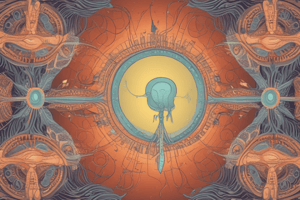Podcast
Questions and Answers
What is a characteristic of R-selected species?
What is a characteristic of R-selected species?
- They invest more time and resources in fewer offspring
- They produce fewer offspring with high parental investment
- They live in stable environments with fewer predators
- They produce large numbers of offspring with little parental investment (correct)
Why do R-selected species produce large numbers of offspring?
Why do R-selected species produce large numbers of offspring?
- To ensure all offspring receive parental care
- To increase chances of survival in high mortality environments (correct)
- To have fewer offspring but invest more resources in each
- To compete with K-selected species for resources
Which common misconception about animal reproduction is refuted in the text?
Which common misconception about animal reproduction is refuted in the text?
- Reproduction is limited to a single pair in all species
- All animals reproduce through monogamous mating systems
- Reproduction is only limited to specific breeding seasons (correct)
- All species produce the same number of offspring
What is a key difference between K-selected species and R-selected species?
What is a key difference between K-selected species and R-selected species?
Why do K-selected species invest more time and resources in fewer offspring?
Why do K-selected species invest more time and resources in fewer offspring?
What is an implication of understanding animal reproduction for conservation efforts?
What is an implication of understanding animal reproduction for conservation efforts?
What are the two main categories of reproduction in animals?
What are the two main categories of reproduction in animals?
Which type of reproduction creates offspring with a mix of genetic material from both parents?
Which type of reproduction creates offspring with a mix of genetic material from both parents?
In asexual reproduction, how do offspring compare genetically to the parent organism?
In asexual reproduction, how do offspring compare genetically to the parent organism?
Why is genetic variability important in sexual reproduction?
Why is genetic variability important in sexual reproduction?
When is asexual reproduction more common?
When is asexual reproduction more common?
What is the advantage of sexual reproduction over asexual reproduction?
What is the advantage of sexual reproduction over asexual reproduction?
Flashcards are hidden until you start studying
Study Notes
Reproduction is a fundamental process in biology that allows every species on Earth to perpetuate itself. It involves the production of offspring that share genetic material with their parents, ensuring the continuity of the species. In this article, we will explore the various aspects of reproduction in animals, including how it occurs, the types of reproductive strategies employed by different groups, and some common misconceptions about animal reproduction.
How Does Animal Reproduction Occur?
Reproduction in animals is typically divided into two main categories: sexual reproduction and asexual reproduction. Sexual reproduction, which is found in most animal species, involves the fusion of two haploid gametes (sperm and egg) to form a diploid organism. This process creates offspring with a mix of genetic material from both parents, ensuring genetic variability and increasing the chances of survival in the face of environmental changes and predators.
Asexual reproduction, on the other hand, occurs when a single organism produces offspring that share the same genetic material as the parent. This method is more common in relatively stable environments where genetic variation is less critical for survival, and it allows for rapid population growth without the need for a mate.
Types of Reproductive Strategies
Reproduction in animals can be further divided into several types of reproductive strategies based on the level of parental investment and the number of offspring produced. These strategies include:
-
R-selected species: These animals produce large numbers of offspring with relatively little parental investment. They often live in environments with high rates of mortality and limited resources, so producing many offspring increases the chances that at least some will survive.
-
K-selected species: These animals produce fewer offspring but invest more time and resources in them. They typically live in stable environments with fewer predators and less competition for resources, so investing in fewer, well-cared-for offspring can lead to greater chances of survival for the species.
Common Misconceptions about Animal Reproduction
Despite the many studies and observations about animal reproduction, some common misconceptions persist:
-
Reproduction is limited to the breeding season: Many animals can reproduce year-round, but their reproductive efforts are focused during specific times of the year due to environmental factors such as food availability and optimal temperatures for gestation.
-
Reproduction is limited to a single pair: While some animals, like elephants and primates, typically form pair bonds, many animals reproduce through polygamous or promiscuous mating systems, with multiple males and females contributing to offspring.
-
All species have the same number of offspring: The number of offspring produced by a species can vary greatly, from a few to hundreds or thousands, depending on factors such as parental care, environmental conditions, and the type of reproductive strategy employed by the species.
Implications for Conservation
Understanding animal reproduction is crucial for conservation efforts. By studying the reproductive strategies of different species, biologists can gain insights into the factors that contribute to their success in the wild. This knowledge can then be used to develop strategies for protecting endangered species and preventing further declines in population numbers.
In conclusion, while the processes involved in animal reproduction may seem basic, they are complex and diverse, reflecting the varied needs and conditions faced by each species. By understanding these processes, we can gain insights into the forces that shape evolution and guide our efforts to conserve and protect the world's diverse array of animal life.
Studying That Suits You
Use AI to generate personalized quizzes and flashcards to suit your learning preferences.




